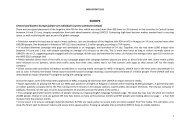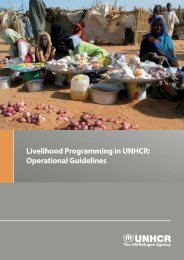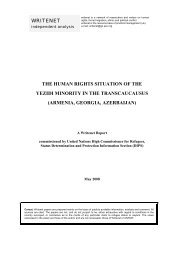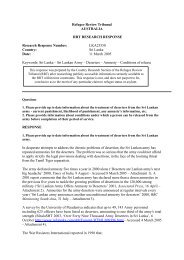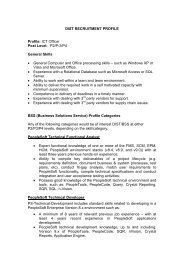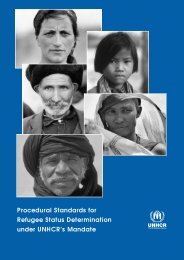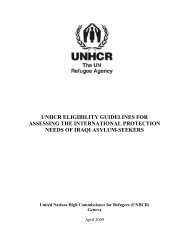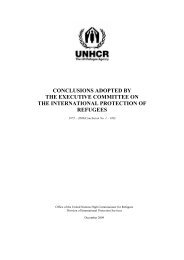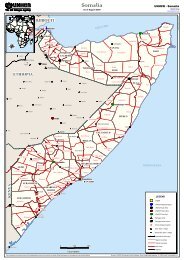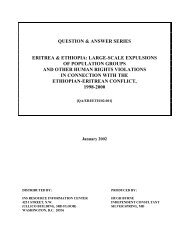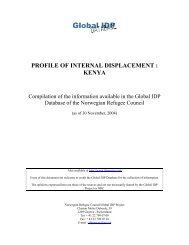UNHCR's ELIGIBILITY GUIDELINES FOR ASSESSING THE ...
UNHCR's ELIGIBILITY GUIDELINES FOR ASSESSING THE ...
UNHCR's ELIGIBILITY GUIDELINES FOR ASSESSING THE ...
You also want an ePaper? Increase the reach of your titles
YUMPU automatically turns print PDFs into web optimized ePapers that Google loves.
Al-Sunna. In addition, members of the educated elite such as journalists, doctors,<br />
academics and teachers, have been frequent targets. 101<br />
There are reports that insurgents have infiltrated parts of the ISF. 102 For example, several<br />
brigades of the Ministry of Defence in charge of protecting oil pipelines have been accused<br />
of running death squads killing (Shi’ite) Government officials and appear to have links to<br />
insurgency groups. 103<br />
Iraqi Government officials blame the Sunni parties for supporting “terrorism”, in particular<br />
the Iraqi Islamic Party (IIP), the largest Sunni Muslim bloc in the Council of<br />
Representatives, and the Association of Muslim Scholars (AMS), the most influential Sunni<br />
organization in Iraq. 104 However, it is unclear how closely these parties are involved in<br />
directing or funding the insurgency.<br />
2. Iraqi Security Forces and Shi’ite militias<br />
Shi’ite-dominated ISF and militias, often wearing police or Special Forces uniforms, 105<br />
regularly target members of the Sunni population. 106 Those targeted include also Sunni<br />
Arab refugees such as Palestinians and those from Syria and Iran, 107 as well as former<br />
members of the Ba’ath Party and security services, 108 who are considered supporters of the<br />
former regime and the ongoing insurgency. The fact that Shi’ite militias have infiltrated or<br />
collaborate with the ISF 109 blurs the line between state and non-state actors. 110<br />
101<br />
See “Certain Professions”.<br />
102<br />
UNAMI HRO, December 2006 Human Rights Report, p. 8, see above footnote 10.<br />
103<br />
Dexter Filkins, Armed groups propel Iraq toward chaos, The New York Times, 24 May 2006,<br />
http://www.iht.com/articles/2006/05/24/africa/web.0525police.php.<br />
104<br />
See, for example, Ned Parker and Ali Hamdani, How violence is forging a brutal divide in Baghdad, The<br />
Times, 14 December 2006, http://www.timesonline.co.uk/tol/news/world/iraq/article753899.ece. See also:<br />
UNHCR, 2005 Country of Origin Information Iraq, p. 15, see above footnote 53.<br />
105<br />
Damien Cave, In Iraq, It’s Hard to Trust Anyone in Uniform, The New York Times, 3 August 2006,<br />
http://www.nytimes.com/2006/08/03/world/middleeast/03uniforms.html.<br />
106<br />
See “Shi’ites and Sunnis Civilians” and “Sunni Arabs”.<br />
107<br />
See “VI. EFFECTIVE PROTECTION OF REFUGEES OF ARAB ORIGIN IN IRAQ”.<br />
108<br />
See “Members and Associates of the Ba’ath Party and the Former Regime”.<br />
109<br />
According to the US Department of Defense, “(m)ilitia influence exists in the Iraqi Police”. However,<br />
“there is currently no screening process specifically designed to ascertain militia allegiance. Recruits take an<br />
oath of office denouncing militia influence and pledging allegiance to Iraq’s constitution”; see US<br />
Department of Defense, p. 34, see above footnote 73. See also: Robert Perito, Reforming the Iraqi Interior<br />
Ministry, Police, and Facilities Protection Service, USIP, USIPeace Briefing, February 2007,<br />
http://www.usip.org/pubs/usipeace_briefings/2007/0207_iraqi_interior_ministry.html; The Library of<br />
Congress, see above footnote 72; HRW, Iraq: End Interior Ministry Death Squads, 29 October 2006,<br />
http://hrw.org/english/docs/2006/10/29/iraq14473.htm.<br />
110<br />
See, for example, Filkins, see above footnote 103.<br />
40




